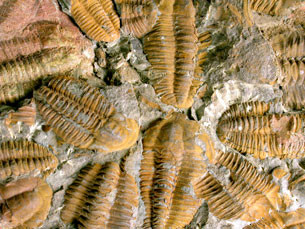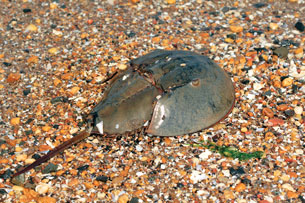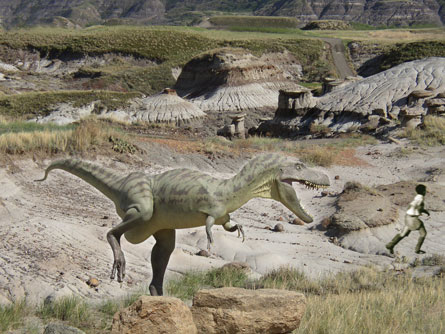Module 4 Intro
1. Module 4 Intro
1.17. Page 2
Module 4—Mechanisms of Population Change
 Explore
Explore
 Read
Read
A variety of evidence for evolution exists. This includes the following:
- fossils
- biogeography
- anatomy
- embryology
- molecular biology and genetics
 Watch and Listen
Watch and Listen
The following animation is the first of several that will appear throughout this lesson. Each one looks at a piece of evidence that supports Darwin’s theory of evolution. The first animation deals with fossils and supports what you will read here and in the textbook.
 Read
Read
Evidence for Evolution—Fossils
You have probably seen fossils like the ones in this photo. They are trilobites, and these organisms don’t exist today. Trilobite fossils can be found in Alberta and all over the world. Trilobites became extinct about 245 million years ago, but at one time there were more than 17 000 different species of them. The closest living relative to trilobites is likely the horseshoe crab.

© Ismael Montero /Dreamstime

© Jessica Fitzel/Dreamstime
Fossils appear in chronological order in the rock layers, or strata. Studying the order of the fossils can help determine their age. The order of the fossils can also help scientists organize evolutionary family trees. Fossils can help show the evolutionary lines between ancestors and living species.
This animated image shows how fossils in the different strata layers can give valuable information to scientists.
Read the sections titled “The Fossil Record” and “Transitional Fossils” in the textbook, starting on page 126 and continuing to page 130. One example of a transitional fossil discussed in the textbook is Archaeopteryx. Click here to confirm your understanding of transitional fossils.
 Self-Check
Self-Check
SC 1. Why is Archaeopteryx considered a transitional fossil?
 Self-Check Answer
Self-Check Answer
SC 1. Archaeopteryx has characteristics of both reptiles (dinosaurs) and birds. It had feathers, but it also had teeth, claws, and a bony tail.
 Try This
Try This
Many movies portray prehistoric cave dwellers and dinosaurs living together. Was this really possible? Did birds evolve before or after fish? Use “Figure 4.10” on page 128 of the textbook to answer these questions. Study the geological time scale, and then try to complete the puzzle that follows.

A common misconception is that humans and dinosaurs lived on Earth at the same time. Humans actually evolved over 55 million years after the dinosaurs became extinct! Dinosaurs fascinate children and adults alike. It is hard to imagine such different creatures roaming Earth.
 Read
Read
Evidence for Evolution—Patterns of Distribution
Biogeography is the study of the past and present geographical distribution of organisms. At one time, all of the continents were linked together and referred to as Pangaea. The movement of the continental plates helps to predict when and where animals evolved. View this information, and then read “Patterns of Distribution” on page 130 in the textbook.
 Self-Check
Self-Check
SC 2. How many million years ago did South America and Africa break apart?
SC 3. When did India become part of Asia?
SC 4. Why are similar fossils of the reptile Cynognathus found in Africa and South America?
SC 5. Why are there no polar bears in Antarctica or penguins at the North Pole?
 Self-Check Answers
Self-Check Answers
SC 2. They broke apart from 110 to 120 million years ago.
SC 3. India became part of Asia from 23 to 30 million years ago.
SC 4. Africa and South America were once joined in one “supercontinent.”
SC 5. Antarctica and the North Pole were not connected when penguins and polar bears evolved.